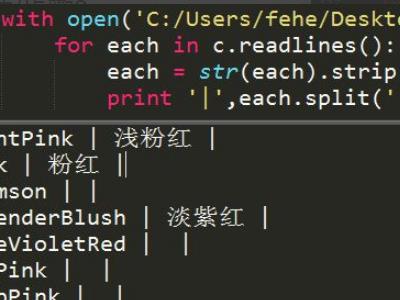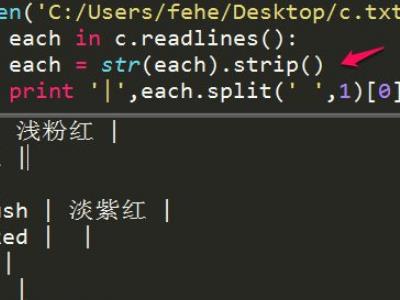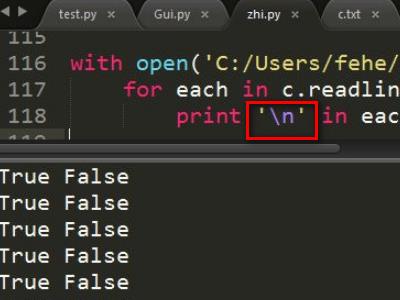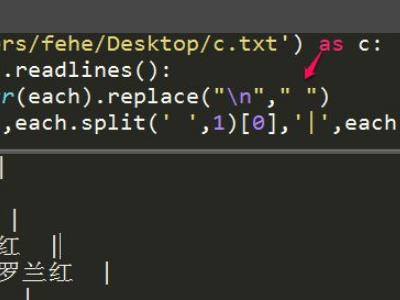python按行读取文件,如何去掉换行符"\n
Posted
tags:
篇首语:本文由小常识网(cha138.com)小编为大家整理,主要介绍了python按行读取文件,如何去掉换行符"\n相关的知识,希望对你有一定的参考价值。
1、打开需要修改的文件代码。

2、因为有中文的缘故,strip(),rstrip(),strip('\\n')等等都会丢失数据。

3、改用replace函数。先看看这里的换行符到底是哪个,是‘\\n’。

4、替换。注意这里把‘\\n’替换成了‘ ’(空格)。成功。

5、注意这里的split函数,设置了‘ ’空格来分离,而且设置了分离的次数。如果直接使用纯粹的split()函数,结果是不正确的,部分中文信息丢失。

说明:
python按行读取文件直接使用for in open方式即可,去除'\\n',可以使用两种方法,一种是替换函数:replace('\\n','')把换行符替换成空;一种是去除空白字符函数:rstrip('\\n')就是把字符串末尾指定字符删除,这里删除换行符('\\n')。
代码:
方法1:
for line in open('要打开的文件名', 'r'): # 打开文件rs = line.replace('\\n', '') # 替换换行符
print(rs) # 显示替换后的行
方法2:
for line in open('要打开的文件名', 'r'): #打开文件rs = line.rstrip('\\n') # 移除行尾换行符
print(rs) # 输出移除后的行
函数说明:
replace(...)
S.replace(old, new[, count]) -> str
返回S出现的所有old子串的换成new子串的字符串。如果可选参数count指定,只有第一计数出现被替换。
rstrip(...)
S.rstrip([chars]) -> str
返回字符串S结尾去掉空格的副本。如果参数字符给出,则只删除指定字符,而不是空格。
参考技术B 换行符与其他字符并没有区别由于换行符总是最后一个字符,所有直接选择除去最后一个字符的所有字符即可
x = 'abc\n'
x[:-1]
也可以使用字符串的strip方法
但是strip方法除了会去掉换行符还会去掉空格等其他字符
x.strip()本回答被提问者采纳 参考技术C line = line.strip('\n\r')
python如何随机读取一行
有一个txt里面几百万行,请问用python如何随机的读取其中一行呢?
#!/usr/bin/env python# coding: utf-8
def getfilelines(filename, eol='\\n', buffsize=4096):
"""计算给定文件有多少行"""
with open(filename, 'rb') as handle:
linenum = 0
buffer = handle.read(buffsize)
while buffer:
linenum += buffer.count(eol)
buffer = handle.read(buffsize)
return linenum
def readtline(filename, lineno, eol="\\n", buffsize=4096):
"""读取文件的指定行"""
with open(filename, 'rb') as handle:
readedlines = 0
buffer = handle.read(buffsize)
while buffer:
thisblock = buffer.count(eol)
if readedlines < lineno < readedlines + thisblock:
# inthisblock: findthe line content, and return it
return buffer.split(eol)[lineno - readedlines - 1]
elif lineno == readedlines + thisblock:
# need continue read line rest part
part0 = buffer.split(eol)[-1]
buffer = handle.read(buffsize)
part1 = buffer.split(eol)[0]
return part0 + part1
readedlines += thisblock
buffer = handle.read(buffsize)
else:
raise IndexError
def getrandomline(filename):
"""读取文件的任意一行"""
import random
return readtline(
filename,
random.randint(0, getfilelines(filename)),
)
if __name__ == "__main__":
import sys
import os
if len(sys.argv) == 1:
print getrandomline("/home/tim/documents/users.csv")
else:
for f in filter(os.path.isfile, sys.argv[1:]):
print getrandomline(f)
对于超大文件建议用逐行或分块的方式处理;逐行处理可能慢一些,但编码更简单清晰一点;上面给出的是按分块方式处理的。
#use:python xx.py file
import random
import sys
def random_read(read_file):
count = 0
for count, line in enumerate(open('read_file','rU')):
count += 1
line = random.randint(0,count-1)
f = open('read_file','r').readlines()[line]
print f
def main():
if len(sys.argv) != 2:
print 'use: %s filename' % sys.argv[0]
sys.exit(1)
read_file = sys.argv[1]
random_read(read_file)
if __name__ == "__main__":
main()追问
对不起 我想要python3的,另外能不用python xx.py file这种命令行形式吗?直接open('test.txt。改好后我再给你加分
追答改最后面就行了
if __name__ == "__main__":
random_read('test.txt') #最好带路径
开头加个这个#!/usr/bin/env python 运行的时候直接./xx.py就可以了
python3应该库跟语法都不一样吧
这个逻辑很简单 你可以自己尝试一下变成python3的代码:)
#coding=utf-8
#! /usr/bin/python
import random
import linecache
def hello():
count = len(open('hello.txt','rU').readlines())#获取行数
hellonum=random.randrange(1,count, 1)#生成随机行数
return linecache.getline('hello.txt',hellonum)#随机读取某行
if __name__ == "__main__":
hello()
参考技术C import random
f=open('a.txt')
randomLineNumber=int(raw_input('Please input a random line no.:').strip())
for i in range(randomLineNumber):
x=f.tell()# get the current position of the file
f.readline()
if x==f.tell():
print "Error: The file only has %d lines, so, "%i+\\
"it's impossible to get the line you want!!!"
exit(1)
print f.readline()[:-1]
f.close() 参考技术D 试试这个方法:http://computer.uoh.edu.cn/python/634.html
以上是关于python按行读取文件,如何去掉换行符"\n的主要内容,如果未能解决你的问题,请参考以下文章